You can help expand this article with text translated from the corresponding article in German. (April 2022)Click [show] for important translation instructions.
|
This is a list of coats of arms of Germany.
You can help expand this article with text translated from the corresponding article in German. (April 2022)Click [show] for important translation instructions.
|
This is a list of coats of arms of Germany.
The origins of the coats of arms of German federal states covers the historical context for the current arms of the German länder.
After the end of the Third Reich, Germany had lost significant parts of its territory and was divided into four occupation zones. Several former states were split between two or more of these zones. The historical state of Prussia, which spread over more than half the territory of Germany, was officially abolished by the Allies; and several new states were formed from its former lands while other parts were annexed by Poland or the USSR.
Some of these states were direct successors of former states, although the former borders changed; others were new constructions. In some cases parts of former states were declared states; in other cases, parts of different states formed a new state. Only the historic city-states of Hamburg and Bremen survived the end of the Third Reich without significant changes of their territory.
The Federal Republic was joined by the Saarland in 1957 and by five states of the former German Democratic Republic in 1990. Each of these states adopted new arms upon joining the federation, by combining the centuries-old coats of the former states (or ruling houses) from whose territories they were formed.
| | This section needs expansion. You can help by adding to it. (December 2009) |
Coats of arms of German colonies were prepared but never formally granted. [1]
In 1914, the diplomat Wilhelm Solf proposed that Germany's colonies be assigned flags and arms, like the flags and arms used by the British colonies. Solf believed that these would serve to advertise Germany's power, and would encourage German pride amongst the colonials. Kaiser Wilhelm was enthusiastic about the idea, and drafts were prepared for his inspection by Solf in conjunction with the Heraldry Office and the Duke of Mecklenburg. However, World War I broke out before the project was finalised, and the arms were never actually taken into use. This was in part because giving the colonies their own insignia in times of war could have let them have symbols to rally around in rebellion. [2] Following the defeat in the war, Germany lost all its colonies and the prepared arms were therefore never granted.
The arms all followed a similar style. In chief was placed the Imperial Eagle, bearing a shield with the arms of the House of Hohenzollern. In the main part of the shield was a colony specific symbol, such as an elephant for the colony of Kamerun. Above the shield was placed the German State Crown (which was merely symbolic, and did not physically exist). Early drafts included a scroll displaying the name of the colony or protectorate in German, but given the unheraldic nature of such a name scroll, it is unlikely this would have been part of the final blazon.
 |  |  | 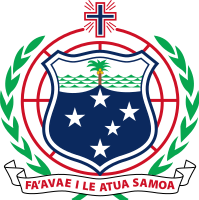 |  |  |
| German New Guinea ( Papua New Guinea ) | German Samoa ( Samoa ) | German South-West Africa ( Namibia ) | |||
 | 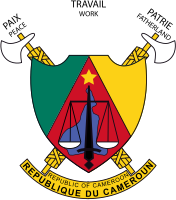 |  |  | 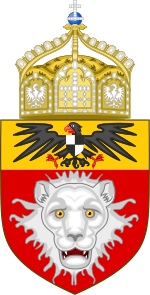 | 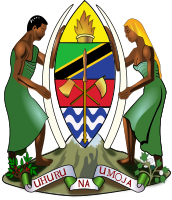 |
| Kamerun ( Cameroon ; parts of territory voted to join Nigeria) | Togoland ( Togo ; parts of territory voted to join Ghana) | German East Africa (Tanzania; parts of territory became states of Rwanda and Burundi) | |||

The Federal Republic of Germany, as a federal state, consists of sixteen states. Berlin, Hamburg and Bremen are called Stadtstaaten ("city-states"), while the other thirteen states are called Flächenländer and include Bavaria, Saxony, and Thuringia, which describe themselves as Freistaaten.

Prussia was a German state located on most of the North European Plain, also occupying southern and eastern regions. It formed the German Empire when it united the German states in 1871. It was de facto dissolved by an emergency decree transferring powers of the Prussian government to German Chancellor Franz von Papen in 1932 and de jure by an Allied decree in 1947. For centuries, the House of Hohenzollern ruled Prussia, expanding its size with the Prussian Army. Prussia, with its capital at Königsberg and then, when it became the Kingdom of Prussia in 1701, Berlin, decisively shaped the history of Germany.

Frederick II was the last sovereign Grand Duke of Baden, reigning from 1907 until the abolition of the German monarchies in 1918. The Weimar-era state of Baden originated from the area of the Grand Duchy of Baden.
These are lists of political office-holders in Germany.
The state of Prussia developed from the State of the Teutonic Order. The original flag of the Teutonic Knights had been a black cross on a white flag. Emperor Frederick II in 1229 granted them the right to use the black Eagle of the Holy Roman Empire. This "Prussian Eagle" remained the coats of arms of the successive Prussian states until 1947.

The coat of arms of the German state of Baden-Württemberg features a greater and a lesser version.

The coat of arms of Baden comes from the personal arms of the Margraves and Grand Dukes of Baden, the traditional rulers of the region. Following the revolution and abolition of the Grand Duchy in 1918, the arms and griffin supporters were usurped from the Grand Dukes by the new republic to represent the people and country.

German heraldry is the tradition and style of heraldic achievements in Germany and the Holy Roman Empire, including national and civic arms, noble and burgher arms, ecclesiastical heraldry, heraldic displays and heraldic descriptions. German heraldic style is one of the four major broad traditions within European heraldry and stands in contrast to Gallo-British, Latin and Eastern heraldry, and strongly influenced the styles and customs of heraldry in the Nordic countries, which developed comparatively late. Together, German and Nordic heraldry are often referred to as German-Nordic heraldry.

The coat of arms of the Kingdom of Württemberg shows an impalement of the three black antlers that represent Württemberg on the dexter side, and the three black lions passant of medieval Swabia on the sinister side, both on a gold field.

The German Empire consisted of 25 constituent states and an imperial territory, the largest of which was Prussia. These states, or Staaten each had votes in the Bundesrat, which gave them representation at a federal level.

The House Order of Albert the Bear was founded in 1836 as a joint House Order by three dukes of Anhalt from separate branches of the family: Henry, Duke of Anhalt-Köthen, Leopold IV, Duke of Anhalt-Dessau, and Alexander Karl, Duke of Anhalt-Bernburg.

Württemberg is a historical German territory roughly corresponding to the cultural and linguistic region of Swabia. The main town of the region is Stuttgart.

The House Order of Henry the Lion In German: Hausorden Heinrichs des Löwen, was the House Order of the Duchy of Brunswick. It was instituted by William VIII, Duke of Brunswick on 25 April 1834. The ribbon of the Order was red with yellow edges. It had five grades: Grand Cross, Grand Commander with Sash, Commander, Knight 1st Class, Knight 2nd Class, plus Medal of Merit for Science and Arts, the Cross of Merit and the Medal of Honour. The Order was named in honour of Henry the Lion, who remains a popular figure to this day.
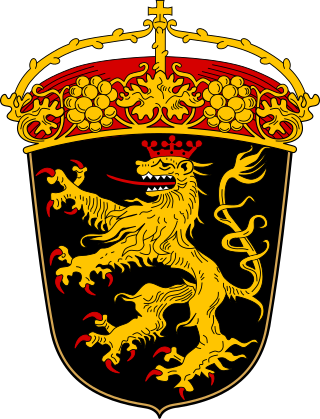
The Palatine Lion, less commonly the Palatinate Lion, is an heraldic charge. It was originally part of the family coat of arms of the House of Wittelsbach and is found today on many coats of arms of municipalities, counties and regions in South Germany and the Austrian Innviertel.
The Principality of Schaumburg-Lippe and the United States mutually recognized each other in 1845, but never formally established diplomatic relations. Relations continued when the Principality joined the North German Confederation in 1867 then joined the German Empire in 1871. Relations would eventually end with World War I when the U.S. declared war on Germany.